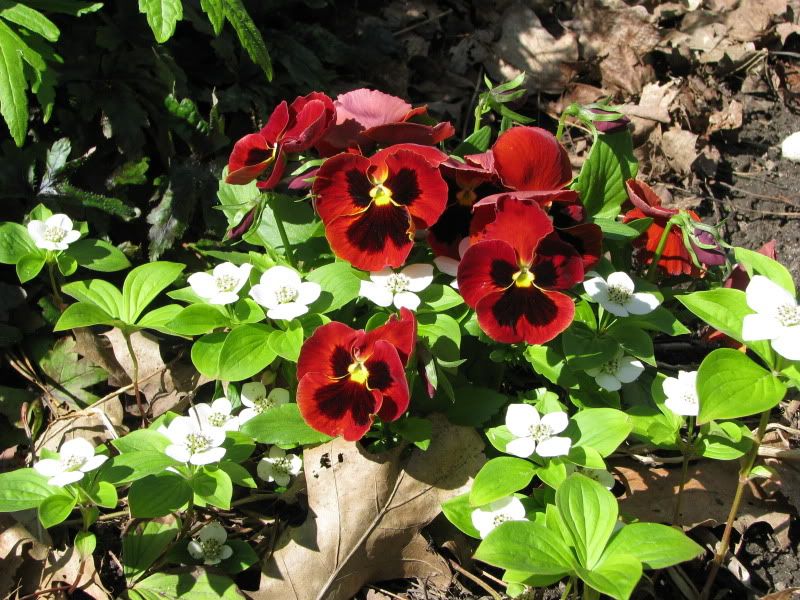
White flowers of bunchberry have invaded a pansy (edible petals*), that has overwintered several years running, to make this bouquet.
Cornus canadensis is a northern north american native with a span from east to west. It is a forest dweller, forming thick carpets of four petaled dogwood flowers in late spring to early summer, followed by edible berries. To grow well, it needs acidic soil that doesn't dry out. Not only do I know this by reading, but I have this on authority from the local expert on natives at the Native Plant Sale at the Wildlife Fletcher Garden that I attended yesterday. We had this conversation:
Plant Expert (talking to another customer, I'm just snooping): It really needs acidic soil to do well which is probably why you haven't had success with it.
Buyer: Oh, well yes.
Plant Expert: I haven't had it work either.
Me (butting in): I have bunchberry that grows well in my soil though it's pretty nuetral.
Plant Expert: Is your soil sandy?
Me: Um, yup.
Plant Expert: The conditions must be good enough that it is overcoming its requirements. If you had it against the foundation with all that lime leaching in the soil, it probably wouldn't do well.
Me: Hmm. Guess some plants surprise us with their tolerances.
Me (thinking to myself): Actually, it is against the foundation. Oops.
It is planted on the north side of my house (against the foundation), in a bed heavily enriched with leaves, many of which are the acidifying oak leaves so maybe I have managed to acidify the soil at least locally though when I infrequently check the pH, I find it nuetral. My friend gave me the bunchberry with the warning that it spreads. He has his planted near the house foundation as well though he also has an evergreen nearby which might be helping in the acid department.
Back to the berries. They are described as suvival food which should give you a good idea of their palatibility or lack thereof. I like to give them the more flattering description of children's berries as children seem to overcome their ick factor in the garden and eat anything that won't kill them. Anyhow, they are pretty, grow in a woodland setting, are native and have bland but acceptible taste. If you have acidic soil, they make a nice ground cover.
And another thing:
More on the Native Plant Sale
I didn't manage to come home with too many edibles this time as the Viburnum cassinoides or Wild Raison was walked away as I was about to pick it up, but I did get a number of lovely natives including tall sunflower, pearly everlasting, bellwort, prairie smoke, canadian wild ginger (root edible), blue stemmed goldenrod, st. john's wort (bushy, I think), nodding onion (also edible), and a plant whose name I can't remember... oh yes, it was a wild time.
I highly encourage anyone interested in creating an eco-friendly garden to check out this sale next year. Also, go to the gardens, as they have an beautiful example of an urban garden using entirely native plants behind the information building, along with a butterfly meadow, forest walk and amphibian pond. It is pretty accesible for strollers as well.
* Pansy petals are edible but be careful when trying any new food, especially if you have allergies to pollen, or a similar plant. Avoid the pollen producing parts to be extra safe. That said, I have never had a problem gobbling edible flowers.

2 comments:
I almost jumped out of my seat when I saw your posting on bunchberry. I planted three plants this year in a mostly shady part of the front-yard garden. I'm very excited to see the blooms and now i know i can give the berries a try too. survival food...i like that. I hope my bunchberry spreads...it is really lovely and the fact that it's native is a huge bonus.
irena
Wow, I can't believe I didn't find your site sooner. I knew I couldn't be the only one blogging on perennial food plants and similar topics. I often found ones just on broader permaculture concepts, or ones on ornamental gardening or ones on vegetable gardening, etc. But none that focused specifically on...well I don't know what to call them "food forests", "edible landscapes"...??...Those terms sound so abstract. But anyway, I'm adding you to my blogroll and look forward to more posts and pictures!
Post a Comment